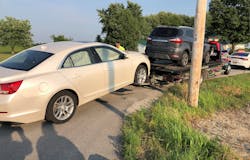I’ve taught air bag technology and service for over 30 years and safely deployed inflator modules in hundreds of training demonstrations. One experience I’ve managed to avoid prior to last year, though, was being involved in an accident when air bags deployed.
On a country road in Madison County, Ind., on July 4, 2021, the corn was over seven feet high and planted nearly to the edge of the pavement on one side of an intersection with a two-way stop. The crops created a blind intersection. We stopped, then crept out into the intersection. But the drivers of two vehicles couldn’t see each other until . . . CRASH . . . it was too late! In an instant that felt like an eternity, my wife and I helplessly watched another vehicle coming toward our car at around 50 MPH, hitting the driver’s side of our vehicle. My wife (Teresa) was driving. After the crash, our vehicle was turned 90 degrees and pushed several yards down the road. I expected the worst, but Teresa was only a little sore and shaken up. I was as well. THANK GOD! Both side curtain air bags deployed on our 2013 Chevy Malibu Hybrid. (Figure 1) When the air bag smoke cleared, I jumped out to check the condition of those in the other vehicle. The driver and sole occupant of the other vehicle (a 2019 Ford EcoSport SUV) had their driver air bag and knee bolster deploy (as designed) and also walked away without serious injury. Restraint system technology works!
Air bag safety
Air bag technology for the repair world has always been about safety and timing. What are some specifics about safety? Professionals reading ABRN are most likely aware of the fundamental safety rules when working with SIR / SRS (supplemental inflatable restraints / supplemental restraint systems), or air bag systems as they’re commonly referred to. This is not a complete list of safety rules, but it highlights information worth noting.
RULE 1
Always turn off the ignition, disconnect the vehicle’s 12-volt battery and allow a few minutes for the restraint system’s electronic control module capacitors to bleed off prior to working on or near a restraint system.
RULE 2
Never improperly dispose of (or expose to heat / flames) an undeployed inflator module or other pyrotechnic device (side curtain modules, seat belt pretensioners, etc.)
RULE 3
Never use an impact driver or hammer near airbag sensors (Figures 2 & 3) or electronic modules (Figure 4) that are part of the supplemental restraint system.
RULE 4
Never deploy (set off) an automotive air bag/belt tensioner without obtaining proper training and following OEM procedures. (Figure 5)
RULE 5
Never tamper with or modify the OEM wiring harness and/or shorting bars (Figure 6) that are in place to prevent accidental air bag / pretensioner deployments.
RULE 6
Never use modified restraint systems (hardware or software) as part of a collision repair. It might “seem to work” (no DTCs) but may not work properly when it needs to (in an accident).
Air bag History, Chemistry, Hardware & Electronics
Air bags, also known as supplemental inflatable restraints (SIR), have been widely used in passenger cars and light duty trucks since the 1980s. When an air bag-equipped vehicle hits another vehicle or immovable object, the “G” forces are sensed by an arrangement of crash sensors (either mechanical or electronic). An electronic control module, most commonly referred to as the SDM, (sensing diagnostic module) then “qualifies” the event as an accident that would require the assistance of an airbag to prevent / reduce the severity of injuries to the occupants of the vehicle. Remember: the word “supplemental” comes before the words “inflatable restraint” in SIR. Safety belts (lap and shoulder) are the vehicle’s primary restraints. SIR inflator modules are deployed (inflated and deflated) with precision timing.
Unlike the scenes in Hollywood movies where the driver side airbag appears as a huge rubber balloon pinning in the driver, inflator modules inflate in milliseconds and deflate in seconds. Deflation must occur as part of the energy absorbing/restraint process. Additionally, the driver may need to see the road/steer the vehicle AFTER an initial impact.
What chemicals make an air bag work? Inside every inflator module, a propellant is ignited by an electronic igniter actuated by the SIR / SRS module. Sodium azide has been the most popular propellant. Sodium azide is basically the solid rocket fuel used by NASA’s Shuttle program for their SRBs (solid rocket boosters). That changed when some vehicle manufacturers began searching for an alternative propellent that created less irritation to the eyes and lungs for crash victims (and cost less money). Several years ago, air bag manufacturer Takata began using ammonium nitrate as a cost-effective alternative. Those inflator modules use ammonium nitrate, which is also is used by the military as an explosive. Over the course of time, this propellant became plagued with issues relating to the material “clumping” from moisture in high humidity climates (desiccant was not used). This created the potential for “uncontrolled ignition” which resulted in several air bag deaths, lawsuits, and a huge recall by Takata and several vehicle manufacturers. Regardless of the propellent used, it burns in order to create high pressures of nitrogen that are sufficient to (1) split the plastic material covering the inflator module) and (2) temporarily inflate at the precise time a nylon tent-like material to give the vehicle occupants a “cushion” from the sudden impact of vehicle interior components (steering wheel, dash, windshield, etc.) Two or more large vents in the air bag fabric allow for the bag to also deflate in order to absorb the body’s energy when it hits it.
Timing is everything for air bags.
If an inflator module deploys a few milliseconds too early, the occupants can suffer similar injuries as if there were no air bags on the vehicle. Too early of an air bag deployment can result in an early air bag deflation before the driver / passenger “meets” the airbag. (Figure 7) When an inflator module deploys too late (or deflates too slow), the occupants are “hit” with another impact as they move toward the impact’s direction. Belt pretensioners assist in reducing a potential "secondary injury" from a late airbag deployment/improperly positioned occupant. Knee bolster air bags (under the steering column) help unbelted drivers in a similar fashion.
More air bag timing
What other technologies do these high-tech systems use to work correctly? More importantly, can improper collision repairs and poor-quality parts adversely affect this precision timing? For greater accuracy in timing the deployment of frontal air bags, some vehicles use EFS (electronic frontal sensors – shown in Figure 2) Sometimes referred to as “pole catchers,” these sensors help determine if the vehicle has struck a utility pole or similar barrier. Mounted behind the vehicle’s grille, if the electronic sensor internal to the SIR/SRS module “sees” an impact reported by the EFS by a long enough time (in milliseconds) prior to the SIR/SRS module’s internal sensor, the impact is classified as utility pole instead of another vehicle or barrier. The frontal air bags (and belt pretensioners) are then deployed with precision timing to reduce injuries / save lives. These little two-wire sensors are smart – communicating with SIR modules via tiny current (milliamp) variations. Obviously, there can’t be any poor electrical connections / voltage drops (post collision repair) that could result in intermittent EFS communications.
Here’s the IMPORTANT side of all this techno mumbo jumbo . . . when inferior aftermarket body components are used, or improper collision repair procedures are used, the result can be a modified collision energy transfer (the vehicle crushes differently) in certain types of crashes. This means the airbag’s timing could be off enough to reduce restraint system performance.
Other restraint systems advances include PODs (passenger occupant detection), multistage frontal inflator modules and some other future technologies not mentioned in this short article. For more information, check out other valuable resources such as I-CAR and Insurance Institute for Highway Safety (IIHS).
My final thought on airbags ends as personal as I started; Teresa and I will be celebrating our 30th wedding anniversary on February 12 next year, thanks to two side-curtain air bags working as designed last year. My prayer is you never have to get “up close and personal” with an unplanned air bag deployment (in the shop or in a collision) and you stay on a path of learning even more about performing proper collision repairs to keep your customers’ vehicle restraint systems working as designed.
About the Author
Dave Hobbs
Dave Hobbs is a senior technical trainer and curriculum developer for Delphi Technologies Aftermarket at BorgWarner Inc. He's Master ASE-certified with L1 (advanced engine performance) & L3 (hybrid) specialist certifications.
He has extensive OEM service and field engineering expertise, with more than 30 years of experience in troubleshooting vehicle systems electronics, with 15 of those years in the independent aftermarket repair business. He has 20 years of experience in training engineers (worldwide) and service technicians in both the OEM and aftermarket arenas, as well as experience in working with postsecondary vocational / community college students as an adjunct instructor.

